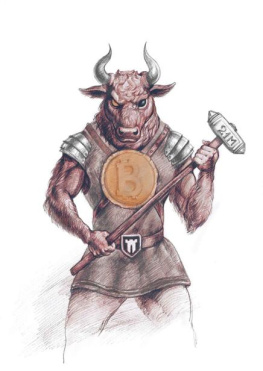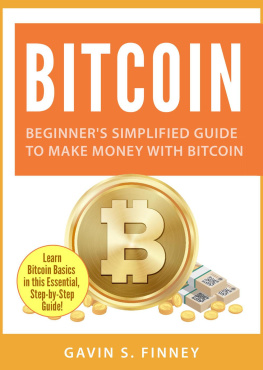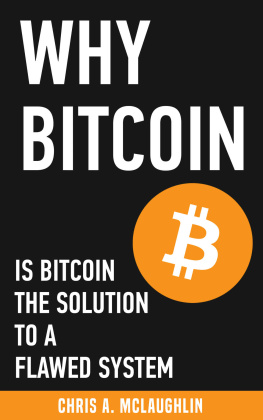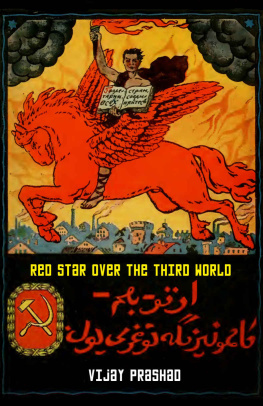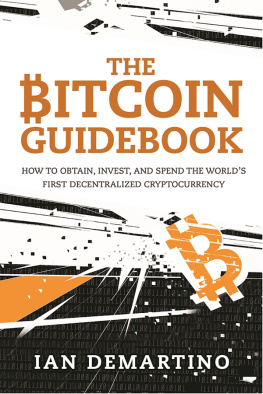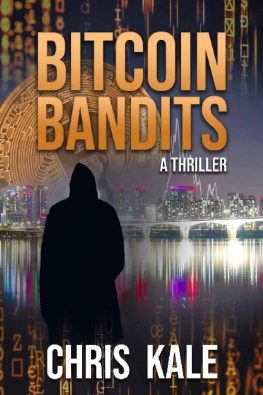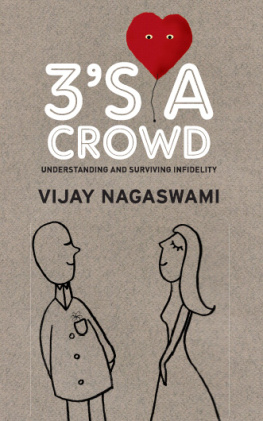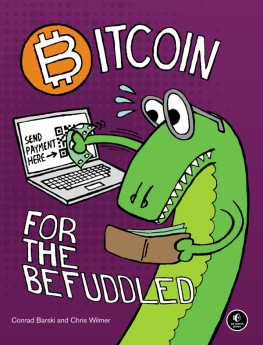Vijay Boyapati - The Bullish Case for Bitcoin
Here you can read online Vijay Boyapati - The Bullish Case for Bitcoin full text of the book (entire story) in english for free. Download pdf and epub, get meaning, cover and reviews about this ebook. year: 2021, genre: Romance novel. Description of the work, (preface) as well as reviews are available. Best literature library LitArk.com created for fans of good reading and offers a wide selection of genres:
Romance novel
Science fiction
Adventure
Detective
Science
History
Home and family
Prose
Art
Politics
Computer
Non-fiction
Religion
Business
Children
Humor
Choose a favorite category and find really read worthwhile books. Enjoy immersion in the world of imagination, feel the emotions of the characters or learn something new for yourself, make an fascinating discovery.
- Book:The Bullish Case for Bitcoin
- Author:
- Genre:
- Year:2021
- Rating:3 / 5
- Favourites:Add to favourites
- Your mark:
- 60
- 1
- 2
- 3
- 4
- 5
The Bullish Case for Bitcoin: summary, description and annotation
We offer to read an annotation, description, summary or preface (depends on what the author of the book "The Bullish Case for Bitcoin" wrote himself). If you haven't found the necessary information about the book — write in the comments, we will try to find it.
The Bullish Case for Bitcoin — read online for free the complete book (whole text) full work
Below is the text of the book, divided by pages. System saving the place of the last page read, allows you to conveniently read the book "The Bullish Case for Bitcoin" online for free, without having to search again every time where you left off. Put a bookmark, and you can go to the page where you finished reading at any time.
Font size:
Interval:
Bookmark:
The Bullish Case for Bitcoin
Copyright 2021 by Vijay Boyapati
All rights reserved.
No part of this publication may be reproduced, distributed, or transmitted in any form or by any means, including photocopying, recording, or other electronic or mechanical methods, without the prior written permission of the author, except in the case of brief quotations embodied in critical reviews and certain other noncommercial uses permitted by copyright law.
ISBN 978-1-7372041-2-1
Front cover and chapter art by @BitcoinUltras.
Charts by Sanjay Mavinkurve.
Cover and interior design by Anton Khodakovsky.
www.bullishcaseforbitcoin.com
Printed in the United States of America
To Addie, Will, and Vivi, for whom I fervently believe
Bitcoin will bring about a better world

The pandemic of 2020 upended the economy of the world, forcing 10 years of digital transformation into the span of months. Pure digital offerings exploded in popularity and many conventional brick-and-mortar services came to a halt. Millions of businesses and billions of people found themselves caught amid the greatest disruption of their lives.
During the second quarter of 2020, our business scrambled to adapt to the new constraints of a post-COVID world. The result was a streamlined enterprise software company with half a billion in cash and more on the way. Our immediate business challenge was resolved, but a larger threat to our survival loomed in the distance.
The United States governments policy response to the pandemic was to triple the rate of monetary inflation. In essence, the cost of capital exceeded 20 percent, while the returns we could expect from any conventional treasury investment strategy were 0 percent. This made our cash stockpile and future cash flows a weight around our neck. A stable, profitable value stock growing substantially slower than the rate of monetary inflation does not serve as a store of value and rapidly loses the support of the investment community.
This problem had existed for a decade leading up the pandemic, albeit at a lower level of intensity. From 2010 through 2019, the rate of monetary inflation was approximately 7 percent and investors relentlessly pressured CEOs and CFOs to grow their cash flows in excess of this rate by any means necessary. That often meant taking on debt and using all free cash flows to buy back stock or to enter into serial acquisitions with a combination of debt and equity in order to keep revenues and expected income growing faster than this hurdle rate. The acquisitions were generally dilutive over the long term, and as management teams struggled to integrate acquisition targets, they lost focus on their core business. When each business became fully leveraged on debt, or when there were no more acquisitions to be had, it reached the end of the line.
The 7 percent hurdle rate resulted in a 99 percent mortality rate during the 20 years after our firm became public, driving one corporation after another to reach beyond their fingertips, impairing their balance sheet with too much debt and convoluting their profit and loss statements with too many disparate business units. When the hurdle rate tripled in the second quarter of 2020, it became clear that we could no longer soldier on with this inflationary burden hanging over our head. If we continued with business as usual, then the value created by millions of activities from thousands of employees each year would be significantly undermined by the decision of a few central bankers to print more money. The road to serfdom consists of working exponentially harder for a currency growing exponentially weaker.
The solution to our problem presented itself in the form of a K-shaped recovery. In essence, Wall Street recovered quickly due to monetary stimulus, while Main Street continued to deteriorate. The key to economic vitality in times of great monetary inflation is a large balance sheet of assets that appreciate faster than the rate of currency debasement. Accordingly, we set off on a search for the right asset mix to place on our balance sheet in lieu of cash and treasury bonds. It was during this search that we discovered Bitcoin and this wonderful thesis crafted by Vijay Boyapati.
The Bullish Case for Bitcoin, first published as a long-form article, represents an intellectual tour de force delivered with elegance and prescience by a polymath well-versed in mathematics, computer science, economics, philosophy, politics, and engineering. After March of 2020, it was evident to me that the world needed a new money based on technology. However, in February 2018, when Boyapati first published his paper, this insight required much greater perspicacity, courage, and conviction.
In a clear and concise manner, Boyapati presents the theory of money, the anatomy of Bitcoin, the reasons it is superior to the gold and fiat standards that came before it, and the promise that it offers to human civilization. He describes path dependence and the trajectory of a newly monetizing asset in terms the layman can understand, and he addresses the concerns that most commonly arise as newcomers struggle to comprehend the essence and significance of this first digital monetary network. I was immediately captivated by The Bullish Case for Bitcoin when I first read it and made it part of the recommended reading for all the officers and directors of my firm as we educated ourselves on Bitcoin and considered the logical path forward. In this book Boyapati updates and significantly expands on the ideas presented in his original article.
In the third quarter of 2020, MicroStrategy decided to adopt Bitcoin as our primary treasury reserve asset, becoming the first publicly traded company to convert to a Bitcoin Standard, and we eventually acquired billions of dollars worth of Bitcoin. We recommend The Bullish Case for Bitcoin to any of our employees, shareholders, or constituents wishing to understand the premise and promise of Bitcoin, both as a digital treasury asset and as the worlds first digital monetary network. I hope you benefit from this work as much as we did.
Michael J. Saylor,
Chairman and CEO MicroStrategy
Miami Beach, Florida
March 27, 2021

The mysterious origins of Bitcoin seem too improbable to be real. While the full details may never be known, we know they went something like this: on January 3, 2009, an unidentified person in an unknown location tapped a key on a computer keyboard and initiated one of the most important programs in history. The computer began searching for a particular pattern known as a hash, a digital needle in a haystack, that would secure the first block in a ledger of financial transactions now known as the blockchain. Within a few minutes or hoursno one knows for sure how longthe first hash was found, thereby completing the genesis block and bringing to life the worlds first truly decentralized digital currency. Remarkably, the identity of the enigmatic figure who created Bitcoin remains unknown, even to this day. All we know is their pseudonym: Satoshi Nakamoto.
Barely two months earlier, on October 31, 2008, Nakamoto had announced a technical specification for Bitcoin to the cryptography mailing list, an email list for people interested in the study of codes and code-breaking. Many of the members of the list referred to themselves as cypherpunks and were determined to reshape society and liberate it from the state using the privacy-enhancing tools of cryptography. Nakamotos email was his very first post to the list, and it received little fanfare and general skepticism after it was posted. Even among this group, steeped in the history of attempts to invent a digital currency, few understood the significance of Nakamotos email announcement. One exception was Hal Finney, a gifted cryptographer and computer scientist who had devoted much of his career to the creation of a digital currency and who was familiar with the inherent difficulties of doing so. Of the announcement of Bitcoin, Finney later recounted:
Next pageFont size:
Interval:
Bookmark:
Similar books «The Bullish Case for Bitcoin»
Look at similar books to The Bullish Case for Bitcoin. We have selected literature similar in name and meaning in the hope of providing readers with more options to find new, interesting, not yet read works.
Discussion, reviews of the book The Bullish Case for Bitcoin and just readers' own opinions. Leave your comments, write what you think about the work, its meaning or the main characters. Specify what exactly you liked and what you didn't like, and why you think so.

